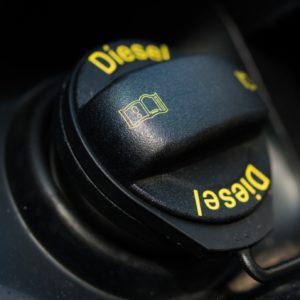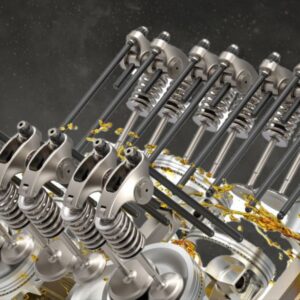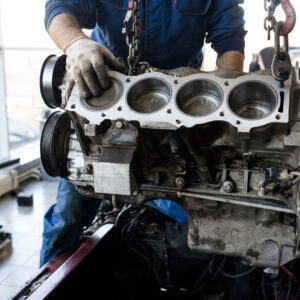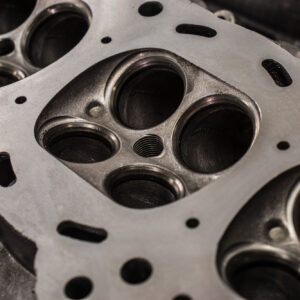Electronic diesel vehicles achieve their fuel economy in part thanks to direct injection (since 1994 with the advent of the Powerstroke Diesel in light trucks).
The technology is now appearing in gasoline engines, significantly improving fuel efficiency and capability. A gasoline direct injection (GDI) engine offers some advantages that make it potentially competitive with EVs and alternative fuels.
But what makes direct injection engines better than standard fuel Injection engines? What is direct injection technology, and how does it work? What are its advantages and disadvantages, and do the benefits outweigh the drawbacks?
What Is a Direct Injection Engine?
Whether it’s diesel or gasoline, a direct injection engine transports fuel right into each combustion chamber rather than injecting it into the intake stream near the neck of the intake valve to be carried into the chamber when the valve opens. Directly injecting fuel into the chamber increases the efficiency and helps burn the air-fuel mixture more evenly and thoroughly because the fuel is better atomized.
How Does a Direct Injection Engine Work?

You can better understand how a direct injection engine works by reviewing the fuel injection process in a standard gasoline engine. Once you know how a gas engine works, you can quickly tell the difference between it and a direct injection engine.
Earlier Gasoline Engines
In earlier gasoline engines, the injectors spray fuel into the air intake manifold right behind the intake valve. The vaporized fuel mixes with air flowing through the intake into the cylinders, creating a misty mixture of atomized gasoline and atmosphere.
When the time is right for each cylinder, the engine opens each cylinder’s intake valve. As the intake valve is opening, the piston is being drawn down into the cylinder because it’s connected to the spinning crankshaft. This enlarges the space in the chamber so that atmosphere and gasoline mist naturally rush in through the open intake valve to fill the vacuum. As the piston reaches the bottom of its travel, the intake valve closes and the piston is driven back up by the spinning crankshaft, compressing the air/fuel mix.
Just before the piston reaches the top of its travel, the spark plug ignites the air fuel mix. The hydrocarbon fuel and oxygen molecules unite with great heat, and the inert nitrogen that makes up nearly 80% of the atmosphere is superheated and drives the piston down, which provides power to turn the crankshaft.
Gasoline Direct Injection
Now, let’s look at a direct injection engine. Instead of delivering fuel to the air intake manifold, the injectors send gasoline directly into the combustion chamber after the air has filled the chamber and has been compressed so that the fuel mist is added at the best possible time and in a very precise way for very complete combustion.
Not only does GDI save time by skipping the waiting period in the air intake manifold before the intake valve on each cylinder opens, it also atomizes the fuel more efficiently.
Regular fuel injection engines have an in-tank fuel pump that produces between 40 and 80 psi to the fuel rail that feeds all the injectors, which are most typically powered by a relay and triggered by the PCM. The fuel rail pressure is either regulated by a diaphragm on the rail or inside the tank by the same type of regulator mounted on the in-tank pump or by a module.
GDI has the same type of low-pressure fuel system, but it feeds a high-pressure fuel pump mounted on the engine that is driven by the camshaft. The high pressure pump is fitted with an integral pressure solenoid and a fuel rail pressure sensor on the injector fuel rail for feedback purposes, giving the ECM/PCM absolute control over the fuel rail pressure, which runs from several hundred to several thousand PSI on GDI engines.
A GDI feeds a high-pressure fuel pump mounted on the engine that is driven by the camshaft. The high pressure pump is fitted with an integral pressure solenoid and a fuel rail pressure sensor on the injector fuel rail for feedback purposes, giving the ECM/PCM absolute control over the fuel rail pressure, which runs from several hundred to several thousand PSI on GDI engines.
–Richard McCuistian, ASE Certified Master Automobile Technician
Why Are Direct Injection Engines More Fuel Efficient?
Direct injection engines achieve their improved fuel efficiency in a couple of ways. First, they increase the ratio of air to fuel, creating a leaner mix. Second, they concentrate fuel in the hottest area of the combustion chamber. Third, they can inject the fuel either all at once or in controlled bursts during a single injection event.
Air-to-Fuel Ratio
The ratio of air versus fuel in a mixture can affect how the engine performs, how much emissions it releases, and how efficiently it burns fuel. Mixes with more air are categorized as lean mixtures, while those with a lower air-to-fuel ratio are rich mixtures.
In homogeneous mode, the air fuel ratio on a GDI engine is around 14.7:1, but in stratified mode, the air fuel ratio can be much leaner, up to 65:1, which improves fuel efficiency and reduces emissions.
Leaner mixtures include less diesel or gasoline. Thus, using an air-fuel mix with a higher air-to-fuel ratio helps direct injection engines improve fuel consumption.

Combustion
A direct injection engine sprays fuel near the spark plug, which is the hottest area of the combustion chamber. The closer to the spark plug, the more completely the air-fuel mixture gets burned.
Meanwhile, a standard gasoline engine disperses its air-fuel mixture in a wide pattern in the combustion chamber. A smaller percentage of the mix stays near the spark plug, which reduces the amount that gets burned more completely.
Direct Injection Fuel System Components
Direct injection engines have fuel injectors and a combustion chamber. Different types of engines might or might not include certain features, so you must check with your owner’s manual or the manufacturer.
A common rail system pressurizes diesel or gasoline before transporting the fuel to the engine. Regular multi-point injection (MPI) systems are basically common rail systems, and the fuel rail may be steel or plastic on these lower pressure systems.
Some direct injection engines rely on a rotary wheel distributor to propel pressurized fuel to the injectors. Other types use an inline pump system that works like a plunger.
In some direct injection engines, the injector and its dedicated pump form an integrated part called a unit direct system. Each cylinder positions one of these systems over it.
Direct injection engines also require a more capable powertrain control module (PCM). Their fuel management system injects fuel into the cylinders at shorter intervals. They also need more precise control of fuel injection and the air-to-fuel ratio in the mixture.
Advantages of a Direct Injection Engine

Direct injection offers significant benefits for engines, especially gasoline-powered ones. The potential performance gains and fuel savings drove engineers to tirelessly work on adapting the technology from diesel engines to gasoline engines until they finally succeeded.
The main advantages of a direction injection engine are the following:
- Starting a cold engine becomes easier
- Improved fuel economy
- Reduced emission profile
- Highly compatible with E85 flex fuel
- Reduced turbo lag on an engine with a turbocharger
- Fuel serves as engine coolant
- Higher compression ratios
Disadvantages of a Direct Injection Engine
Direct injection engines aren’t perfect. They have some drawbacks that might deter interested owners from switching to them.
While gasoline direct injection engines produce fewer overall emissions, they release more nitrogen oxides (NOx) than their conventional counterparts. They also generate more soot, the same toxic particulate matter that makes diesel engine exhaust darker and dirtier.
Direct injection engines also have higher costs. Some of the additional expense comes from their advanced emissions controls, which help them compensate for their higher NOx and soot levels.
Other disadvantages of direct injection engines include the following:
- Lack of fuel flows leads to the intake valves getting dirtier more quickly
- More difficult to increase fuel flow required for some high-performance applications
- Less efficient at handling high fuel flow
- Potentially insufficient power and efficiency at high engine RPMs
- Greater mechanical complexity requires more complicated repairs
- Higher costs for installation and maintenance
Car manufacturers have been working to overcome the drawbacks of direct injection engines. For example, they developed exhaust gas recirculation (EGR) systems and catalytic converters that work specifically with a direct injection engine.
Direct injection engines are generally cleaner and more efficient than their older counterparts. A car that uses a gasoline direct injection engine can save considerable fuel costs and meet stricter emission control standards without sacrificing overall performance.
Any information provided on this Website is for informational purposes only and is not intended to replace consultation with a professional mechanic. The accuracy and timeliness of the information may change from the time of publication.































